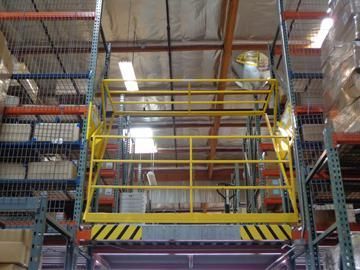
How to Choose the Right Safety Gate Design for Pick Modules
If your facility has pick modules that extend multiple levels, it’s likely there are variety of openings on the elevated levels for picking or for empty pallet/empty tote return bays. Just like the openings on a mezzanine or elevated platform, the areas on a pick module where there is access to the exposed ledge should be secured with dual-gate system. This ensures there is a barrier in place between the picker and the ledge while they are working the pallet, and while the bay is being replenished.
Another major source of fall-related incidents occurs where the empty pallets or empty totes are stacked so they can be removed by the lift truck. These areas should also be secured with a dual-gate system so a barrier is always there to provide fall protection.
There are several dual-gate safety designs available in a rack-supported configuration, but which one is right for you and your application?
Truck or Picking Aisle Must Stay Clear
The original rack-supported dual-gate system was the Rack-Supported Roly gate. This system uses gates that travel in a track system and connected with a chain and sprocket drive system. The gates travel up and down in the track and roll into the pallet drop area. The advantage of this system is that the gates open and close within the confines of the pallet drop area so the gate at the ledge opens and closes flush with the ledge and the rear gate is flush with the rear uprights of the system. Because the gates are flush with the uprights, no part of this safety gate will extend into the truck or picking aisle. The Rack Supported Roly safety gate is often the best solution in a multi-level system so the gates on the lower levels do not interfere with the truck loading the upper levels. Please note, however that a typical upright is only around 48” deep and there needs to be clearances around the 48” deep pallet, so the safety gate is typically designed around 56” deep. This means the rear frame of the safety gate must be permanently positioned behind the upright.
Tall Loads, Fewer Moving Parts
The Rack-Supported Pivot safety gate uses a pivoting framework that utilizes fewer moving parts to provide a safe environment. Because of this, the rear gate pivots back beyond the upright to secure the pallet, then moves out of the way when the ledge gate is closed. This eliminates the need for a permanent structure to be located behind the upright and provides for taller pallet loads. However, by design, this type of gate will extend out into the truck aisle and back into the picking aisle when the gate is operated. With this design, you want to make sure the moving gates will not interfere with the truck aisle, and that there is adequate clearance behind the pallet drop area. Note that the space required for this operation may be an issue if the takeaway conveyor is located right behind the pallet drop area.
Limited Depth on the Platform
If depth on the platform is limited due to the location of the conveyor or a narrow aisle, then your best safety gate solution may be the Rack-Supported Tri-Side gate. This safety system uses a gate that moves straight up and down at the ledge - never extending into the lift truck aisle, and a rear ‘u’-shaped gate that closes to capture the pallet then moves up and out of the way to provide egress behind the area.
All of these Rack Supported safety systems attach directly to the rack-uprights for a solid connection that doesn’t need to be lagged down. They can all be designed to fit the specific rack configuration (upright depth and beam length), and are constructed to match the punching in the rack for an easy, secure connection that doesn’t require any drilling into the rack components. They can be designed in multiple pallet widths or depths, and can accommodate pallet flow lanes. Manual operation is standard, but power operation can be added for remote operations from the lower levels or lift truck.